BMW Z4 vs Toyota Supra: Which Iconic Sports Car Wins?

The BMW Z4 and Toyota Supra are two legendary sports cars that have captured the hearts of driving enthusiasts. Both offer a unique blend of style, performance, and handling, but with distinct approaches. The Z4 is a sleek, open-top roadster, while the Supra is a coupe with a focus on raw power and agility. Which one is right for you? Let’s explore their design, performance, interior features, and pricing to help you make an informed decision.
What will be covered?
- The story behind the BMW-Toyota partnership that birthed these two sports cars
- Design and exterior differences between the Z4 convertible and Supra coupe
- Interior layouts, technology features, and cabin space
- Powertrain specifications and real-world performance numbers
- Driving dynamics – track-focused vs grand touring capabilities
- Trim levels, pricing, and overall value proposition
- A verdict on which sports car is the better buy
So, let’s get started!
The Story Behind the BMW-Toyota Partnership
In a surprising move, German automaker BMW and Japanese giant Toyota joined forces to co-develop a new platform, powertrain, and manufacturing facility. This strategic partnership allowed both companies to share costs and resources.
For Toyota, reviving the iconic Supra nameplate was a top priority, but they needed an inline-six engine. BMW had the perfect powertrain. On the other hand, BMW wanted to keep the Z4 roadster alive while saving money. A collaboration made perfect sense.
After defining the chassis, engine, transmission, and electronics BMW would provide, the two automakers went their separate ways to build their sports cars. The end result? The 2020 Toyota GR Supra and 2020 BMW Z4, born from the same DNA but with distinct personalities.
Design and Exterior Differences
The most apparent distinction between these two-door sports cars is their body style. The BMW Z4 is a classic convertible roadster with a retractable soft top, while the Toyota Supra is a fixed-roof coupe.
In terms of exterior styling, the Supra makes a much bolder statement with its aggressive, muscular lines inspired by the Toyota FT-1 concept. Bulging fenders, sculpted body curves, and an unmistakable “duck bill” spoiler give the Supra an in-your-face presence.
In contrast, the Z4’s design is more subdued and mature, featuring sleek contours and a long hood characteristic of BMW’s styling language. While still attractive, the Z4 doesn’t turn heads quite like the Supra.
Interior and Tech Features
Open the doors, and you’ll immediately notice the heavy BMW influence inside both cabins. That’s because Toyota leveraged many interior components directly from BMW to reduce costs and development time.
The Supra’s dashboard layout, center console, climate controls, gear lever, and even the latest iDrive infotainment system are pretty much lifted from BMW. However, Toyota did make some subtle design changes like unique air vents and gauges to give the Supra’s interior a distinct character.
That said, the Z4 takes things up a notch in terms of luxurious appointments and tech features. Higher-quality materials, more premium trim options, and the latest iDrive 7 system give the BMW’s cabin a more upscale feel.
Both cars offer similar cargo capacity for a two-seater, but the Supra gets bonus points for its rear hatch access and folding rear seats, adding practicality.
Powertrain and Performance
Under the hood, you’ll find the same turbocharged 3.0-liter BMW B58 inline-six engine in both cars, mated to an 8-speed automatic transmission from ZF. However, Toyota’s tuning does result in slightly different power outputs.
In the Supra, this silky-smooth six-cylinder pumps out 335 horsepower and 365 lb-ft of torque. The Z4 M40i variant gets a healthier 382 hp and 369 lb-ft of torque from the same engine.
Despite the power gap, the lighter Supra can keep up with the Z4 in straight-line acceleration. Both rockets to 60 mph in the 3.9-second range and hit the quarter-mile in the low 12-second bracket at over 110 mph.
Where they differ is in the finer areas of performance. The Supra exhibits more noticeable turbo lag off the line but feels incredibly eager to rev once spooled up. The Z4 has a sharper throttle response and feels torquier from low revs.
Track Focused vs Grand Touring Performance
Take these two four-wheeled siblings to a winding road or race track, and their distinct driving characters become evident.
The Toyota Supra feels rawer, louder, and more rambunctious – a pure driver’s car through and through. Its quick steering, stiff suspension tuning, and tenacious grip make it right at home attacking apexes. Slide the tail out, and the Supra reminds you of its lineage as an iconic Japanese sports car.
In contrast, the BMW Z4 takes a more mature, grand-touring approach to spirited driving. It’s sharper and more precise than the average BMW, but there’s an underlying feeling of refinement. The Z4 relishes smooth, flowing corners rather than razor’s-edge dynamics.
Both cars use the same Michelin Pilot Super Sport tires, brakes, and even share a near 50:50 weight distribution. But the Supra feels more hard-edged and eager to party compared to the luxurious yet obedient demeanor of the convertible Z4.
So if you want an intimate connection with the driving experience, the Supra is your weapon of choice. But if you prefer your sports car with a veneer of sophistication, the BMW ticks that box.
Model Pricing and Value Proposition
When it comes to pricing, Toyota undercuts BMW by a significant margin, despite sharing most of the core components and engineering.
The 2023 Toyota Supra starts at $44,635 for the base 2.0L turbocharged four-cylinder model. Stepping up to the inline-six 3.0 Premium trim demands $54,795. At the top, a limited-edition A91-MT Edition with a 6-speed manual adds $3,700 to the price tag.
In comparison, the 2023 BMW Z4 sDrive30i with the 2.0L four-cylinder kicks things off at a higher $51,200 MSRP. The range-topping Z4 M40i variant with the inline-six checks in at $65,700 before any options or packages.
So even when you factor in the slight power deficit, the Toyota Supra represents a better performance-per-dollar value equation, especially at the top end of each lineup. You’re essentially getting the same powertrain and chassis engineering for thousands less.
However, BMW offers a wider range of optional extras, colors, and trim levels to better personalize the Z4 to your tastes. So if you don’t mind paying a premium for the badge and unparalleled levels of customization, the BMW could justify its higher asking price.
The Verdict – Which One to Buy?
After looking at all the facts, figures, and real-world impressions, it’s clear that the BMW Z4 and Toyota Supra appeal to two distinct types of enthusiasts.
If you want the last word in driving purity, loud drama, and all-out performance for the money, the Toyota Supra is the easy choice here. Its bold styling and hard-edged dynamics make it a thrill a minute, honoring its legacy as an iconic Japanese sports car icon.
But if you prefer your speed with a side of luxury and Teutonic sophistication, the BMW Z4 is the one to get. It’s the more mature and well-rounded offering. Plus, BMW’s extensive customization potential lets you spec your perfect roadster.
Can’t decide between the two? Well, the great thing is that you really can’t go wrong with either sports car – both are immensely fun and stay true to their unique brand characters. Just figure out if you want a convertible cruiser or a hardcore coupe.
The BMW Z4 – A Convertible Grand Tourer
The BMW Z4 represents the more well-rounded and luxurious side of this sibling rivalry. As a convertible roadster, it offers the joys of open-air motoring with a premium ambiance that BMW is renowned for.
Under the long hood lies the same turbocharged 3.0L inline-six that powers the Supra, but tuned to produce 382 hp and 369 lb-ft of torque. This gives the Z4 a slight performance advantage, though in real-world driving, the differences are negligible.
Where the Z4 truly shines is in its refined road manners and grand-touring capabilities. The precise yet smooth steering, well-damped ride quality, and restrained cabin noise levels make it an ideal long-distance cruiser when the top is down.
And when you do find a twisty road, the Z4 can certainly keep up and put a smile on your face. It’s sharper and more eager than the average BMW. But it never quite reaches the uncompromising sharpness and agility of a dedicated sports car like the Supra.
The interior is pure BMW luxury, with high-quality materials, cutting-edge tech like the latest iDrive 7 system, and extensive options for customization with premium upholsteries and trim choices. Creature comforts like ventilated seats further add to the Z4’s grand-touring appeal.
If you want an open-top sports car that blends performance with day-to-day livability and premium trappings, the BMW Z4 could be the perfect companion.
The Toyota Supra – A Hardcore Sports Car Resurrected
In contrast, the Toyota Supra leans heavily into its Japanese sports car roots, putting outright performance and driving thrills above all else.
With its aggressive styling inspired by the FT-1 concept, the Supra immediately announces its intentions. The bulging fenders, sculpted body lines, and that unmistakable “duckbill” spoiler give it an in-your-face presence that the Z4 simply cannot match.
Fire up the 3.0L turbo inline-six (335 hp, 365 lb-ft), and the Supra’s personality shines through. The engine note is louder, raspier, with pops and bangs on upshifts. There’s more noticeable turbo lag, but once spooled, the power delivery is incredibly linear and eager to rev.
Chuck it into a corner, and the Supra’s steering is hyper-responsive, with minimal body roll and huge reserves of mechanical grip from the chassis. It communicates and engages the driver in a way the Z4 simply cannot match, owing to the Supra’s dedicated sports car setup.
Yet unlike hardcore sports cars of the past, the Supra doesn’t beat you up on the road. Toyota’s engineers have struck a nice balance between sharp response and decent compliance over bumps. It’s still a focused driver’s car, but one that can be lived with day-to-day.
On the inside, you’ll find most of the fundamentals are shared with the Z4, including the iDrive system and control layouts. But Toyota has added its own unique touches like the racy sports seats and a driver-focused cockpit vibe that further sets the Supra apart.
If your idea of a dream sports car leans more towards a raw, engaging driving experience with dramatic looks and sounds to match, the Toyota Supra is the answer. It brings the iconic nameplate back to its roots as an uncompromising yet livable performance coupe.
Final Thoughts
No matter which of these two legendary sports cars you choose, you’re in for one thrilling drive. The BMW Z4 and Toyota Supra may share roots, but they’ve blossomed into two distinct personalities.
For those who want an open-air grand touring experience with a premium vibe and daily driving compliance, the Z4 is the cultured cruiser of choice. Its refined road manners, luxurious appointments, and cutting-edge tech provide the perfect balance of performance and touring comfort that BMW is known for.
But if you’re a driving purist who values raw feedback, aggressive sporting character, and all-out thrills over outright luxury, there’s no substitute for the Toyota Supra. This Japanese performance icon puts the driver at the center of an immersive and visceral driving experience unlike anything else in its class.
The best part? Thanks to their shared underpinnings, neither the Supra nor the Z4 forces you to break the bank to enjoy world-class sports car engineering and performance. So choose wisely based on your priorities – street cred and driving nirvana, or open-air grandy touring with a side of performance? Either way, you’re in for an iconic experience behind the wheel.





